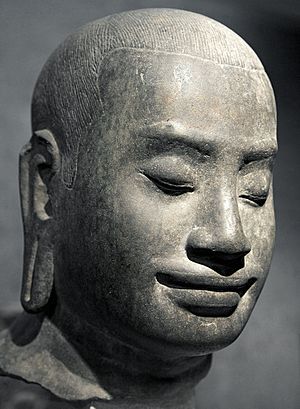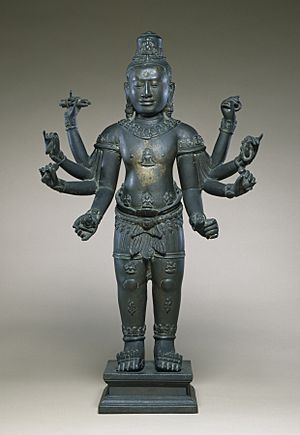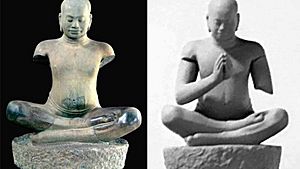Jayavarman VII facts for kids
Quick facts for kids Jayavarman VII |
|||||
|---|---|---|---|---|---|

Bust of Jayavarman VII, Guimet Museum
|
|||||
| King of the Khmer Empire | |||||
| Reign | 1181–1218 | ||||
| Coronation | 1182 | ||||
| Predecessor | Tribhuvanadityavarman (prior to the Cham Invasion) | ||||
| Successor | Indravarman II | ||||
| Born | c. 1122/1125 Angkor, Khmer Empire |
||||
| Died | 1218 (aged c. 95) Yaśodharapura, Khmer Empire |
||||
| Consort | Jayarajadevi, Indradevi | ||||
| Issue | Sikhara Mahadevi (Queen consorts of Pho Khun Pha Mueang) | ||||
|
|||||
| Father | Dharanindravarman II | ||||
| Mother | Sri Jayarajacudamani | ||||
| Religion | Mahayana Buddhism | ||||
Jayavarman VII (born around 1122, died 1218) was a powerful king of the Khmer Empire. His original name was Jayavarthon. He was the son of King Dharanindravarman II and Queen Sri Jayarajacudamani.
Jayavarman VII was the first Khmer king who was truly dedicated to Buddhism. He built the famous Bayon temple as a monument to his Buddhist faith. Many historians believe he was the strongest of all Khmer rulers. His government started many big projects, like building hospitals, roads, rest stops, and temples. Because of his Buddhist beliefs, King Jayavarman VII is known for creating a "welfare state." This means his government worked to help meet the physical and spiritual needs of the Khmer people.
Contents
How Jayavarman VII Became King
In 1177 and 1178, the Cham people invaded the Khmer Empire. In 1177, the Cham King Jaya Indravarman IV launched a surprise attack. His ships sailed up the Mekong River, across Tonlé Sap lake, and then up the Siem Reap River. The invaders attacked the Khmer capital, Yasodharapura, and killed King Tribhuvanadityavarman.
In 1178, when Jayavarman was in his mid-50s, he became a hero. He led the Khmer army to push out the invaders. This included a big naval battle, which you can see carved on the walls of the Bayon and Banteay Chmar temples.
When Jayavarman returned to the capital, he found it in chaos. He brought peace to the different groups fighting for power. In 1181, he was crowned king.
Early in his rule, he likely stopped another Cham attack. He also put down a rebellion in the Malyang kingdom (Battambang). A skilled prince named Sri Vidyanandana, who was a refugee, helped him a lot. This prince also helped in the later attack and takeover of Champa (1190–1191). Jayavarman's conquest made Champa a part of the Khmer Empire for 30 years. He also expanded Khmer control north to Vientiane and south to the Kra Isthmus.
Amazing Buildings and Public Works
During his 37 years as king, Jayavarman started a huge building program. This included both public works and grand monuments. As a Mahayana Buddhist, he said his goal was to make his people's lives better. One old writing says, "He suffered from the illnesses of his subjects more than from his own." This shows how much he cared.
However, building so many monuments needed thousands of workers. Jayavarman's rule also brought more people into bigger cities.
Historians have found different stages in Jayavarman's building plans. First, he focused on useful structures. These included his famous 102 hospitals, rest houses along the roads, and water reservoirs. After that, he built two temples to honor his parents. He built Ta Prohm for his mother and Preah Khan for his father.
Finally, he built his own "temple-mountain" called Bayon. He also developed the city of Angkor Thom around it. He also built Neak Pean ("Coiled Serpent"). This is one of the smallest but most beautiful temples in the Angkor area. It's a fountain with four ponds on an island in an artificial lake.
Ta Prohm Temple
In 1186, Jayavarman dedicated Ta Prohm temple to his mother. An inscription says that this huge temple once had 80,000 people working to maintain it. This included 18 high priests and 615 female dancers.
Angkor Thom and Bayon Temple
Angkor Thom ("Grand Angkor") was a new city center. In its time, it was called Indrapattha. At the center of this new city stands one of his greatest achievements: the temple now called the Bayon. This temple has many faces and towers. It mixes both Buddhist and Hindu art.
Its outer walls have amazing carvings called bas-reliefs. These carvings show not only battles but also the daily life of the Khmer army and their followers. The reliefs show people traveling with animals and oxcarts, hunters, women cooking, female traders selling to Chinese merchants, and celebrations of common soldiers. The carvings also show a naval battle on the great lake, the Tonle Sap.
A Popular Image
The bust (head and shoulders statue) of Jayavarman VII has been a favorite in Khmer homes for many years. It is also a masterpiece at the National Museum. Recently, parts of the rest of his statue were found. This confirmed ideas about his spiritual presence as a ruler.
Important Dates
King Suryavarman II, who built the great Angkor Wat, died in 1150. He was followed by Dharanindravarman II, who ruled until 1160. Because Jayavarman VII was not there, Yashovarman II became king. But Yashovarman II was later overthrown by Tribhuvanadityavarman.
In 1177, the Chams, led by Jaya Indravarman IV, invaded and attacked Angkor. However, some historians, like Michael Vickery, have questioned if this date and event are fully accurate.
In 1181, Jayavarman VII became king after leading the Khmer forces against the Chams. Jayavarman VII then got revenge on Champa in 1190 for their earlier raid in 1177.
Jayavarman died around 1218. He was followed by Indravarman II, who died by 1243. Indravarman was then followed by Jayavarman VIII. Jayavarman VIII was a follower of Shiva, a Hindu god. He started destroying or damaging Jayavarman VII's Buddhist artworks. Most of the Buddha images along the top of the city walls were removed. This included the large Buddha statue at Bayon. The Buddha images in Angkor Thom were changed into linga, which are symbols of Shiva.
Jayavarman's Lasting Impact
The way kingship worked in the Khmer Empire was different from Europe. A Khmer king's sons did not always inherit the throne. Jayavarman VII had many sons, like Suryakumara and Virakumara. His crown prince, Srindrakumaraputra, died before him. But only Indravarman II inherited the throne.
Jayavarman VII built 121 "houses with fire" (rest houses) every 15 kilometers along main roads for travelers. He also built 102 hospitals. His religion was Mahayana Buddhism, also known as "Buddhism of the Greater Vehicle." However, Brahmans (Hindu priests) still played a role in the royal court.
He first married Princess Jayarajadevi. After she died, he married her sister, Indradevi. Many believe these two women greatly inspired him, especially in his strong devotion to Buddhism.
Even though he had many sons, we only know the names of four: Suryakumara, Virakumara, Srindrakumara, and Tamalinda (who later became a Buddhist monk). He was also the father of Sikhara Mahadevi, who was a chief queen of Pho Khun Pha Mueang. Her name appears in a stone carving at Wat Sri Choom in Sukhothai Historical Park.
See also
 In Spanish: Jayavarman VII para niños
In Spanish: Jayavarman VII para niños




